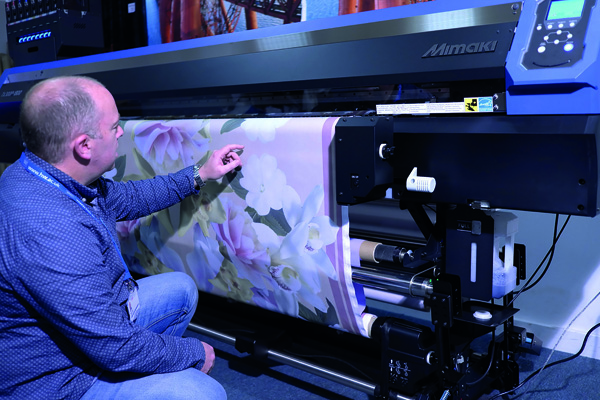…or at least get into educational establishments where tomorrow’s designers can learn about the print technologies they might harness.
RA Smart has become synonymous with textile printing here in the UK. The Macclesfield-based company can print on to any fabric, and lists some of the biggest names in fashion and interiors design among its customers. It has been at the forefront of digital textile technology since the late 1990’s but it also continues to support the screenprint process via its bespoke screen making operation. Then of course it is also a provider of textile print systems to others, so they can get in on the act. Indeed, managing director, Magnus Mighall is practically evangelical about the possibilities of today’s textile print technologies and actively encourages the next generation of designers to understand all the possibilities it offers.
For years, RA Smart has worked with colleges and universities to this end - think the Royal College of Art, London College of Fashion and Central St Martins, The Philadelphia College of Science and Technology, Academy of Arts San Francisco, and the Danish Design School in Copenhagen to name a few - but Mighall believes the likes of the Mimaki Tx300-1800P direct-to-textile wide-format printer marks a sea change.
“Universities have always been a focus for RA Smart, and when digital printing came along for textiles those institutions were some of the first adopters because it met their requirement for short-run sampling etc., initially for fashion students. But, over the last 18 months, we’ve seen real development in digital print technologies for textile that is opening up possibilities to design students across all sorts of disciplines. If we can get those developments in front of all those potential users by putting it into the places where they are educated, then that can only be a good thing.”
Mighall again refers, in particular, to the Mimaki Tx300-1800P, one of the UK’s first having been installed by the company at Heriot Watt University’s School of Textiles and Design. There it has joined a line-up of other Mimaki textile machines, providing the department’s 25 final year ‘Design for Textiles’ students with the ability to output designs onto a range of fabrics for their degree show.
Senior technician, Dr Roger Spark, indicates how the printer is a vital addition to the school’s print capabilities: “Our existing Mimaki printers have served us well for over ten years but with the added capacity of the new Tx300, we’re able to more efficiently deliver the long runs required by our students for their final year collections.”
He adds: “We offer the potential for not only the ‘Design for Textiles’ undergraduates to print their work but also the provision of printed fabric for our ‘Fashion’ students to make into garments in our sewing workshops.”
Citing Heriot Watt’s emphasis on preparing graduates for life in industry, Spark says: “Our graduates tend to follow one of two paths. Many of them are successful in finding positions in the textile industry but we also see students starting up their own fashion and design businesses, as the footing they gain through the courses we offer stands them in good stead for their careers ahead.”
With programmes geared towards fashion and interior design, students benefit from the school’s significant printing capabilities. Along with its three Mimaki printers, the textile department also boasts one of the longest flatbed screenprint tables in education – all installed by reseller RA Smart.
“We’re proud of the enduring relationship we share with Heriot Watt,” says Mighall. “Having supplied and supported the university with screen and digital print equipment for over 25 years, seeing their continued drive to deliver industry-ready graduates into the textile and fashion sector remains as satisfying as ever.”
And there’s the crux of the matter - preparing today’s students to become tomorrow’s designers with a good understanding of what digital textile printing can offer.
“This is a critical time for digital textile print; developments in printer technology, inks, coatings media have all coalesced in what is a really fast growing sector. Issues like runnability, colour yield, washfastness etc. mean there’s now huge scope for digital textile printing. In a nutshell, the new direct-to-print machine from Mimaki - the Tx300P-1800 - allows people to print on anything, and at RA Smart we’re keen to share that knowledge with those who will potentially use it in their careers,” enthuses Mighall.
The 1.8m wide Tx300P-1800 uses reactive, pigment, acid or disperse inks and thus can be used to print to cotton, silk, wool and polyester. With production speeds of up to 55m2/hr it is ideal for short to medium run production of fashion, furnishings and other textiles.
With a critical element in textile printing being accurate colour management, Heriot Watt’s Spark is seeing a tangible benefit in Mimaki’s latest reactive inks and profiles. “The School invested in a suite of Apple Macs running AVA design and colouring software a few years ago, and using these in conjunction with the colour profiles provided with the new Mimaki Rip package is delivering superb results,” he says.
“We waited for the right machine to come along and the new Tx300P-1800 has fitted in to our print room perfectly.”
The Tx300P-1800 is exclusively distributed in the UK and Ireland via Hybrid Services, and Stephen Woodall, national sales manager, textile and apparel, adds: “It’s great to see students benefiting from the latest textile printing technology. Heriot Watt’s undergraduate textile courses offer a unique and valuable opportunity for prospective designers to experience industry standard equipment and processes.”
Hopefully, designers better educated in digital print for textiles, will lead to greater demand.

